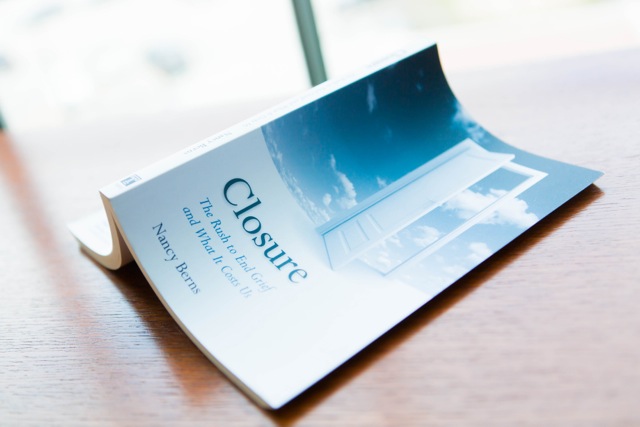From grief counselors to grieving parents, people fight the myth of closure. In Closure: The Rush to End Grief and What It Costs Us, I use the term Myth Slayers to describe people who warn others about the concept of closure. Read on to meet two of them. 
Myth Slayers are people who say, “There is no closure.” Some of them may have a history of expecting closure, but at some point discovered that closure did not exist. Myth Slayers counter each of the assumptions that underlie dominant claims about closure. They argue that closure is not possible, not good, not desired, and not necessary.
Closure is not possible because the pain never completely goes away. Closure is not good because it provides a false hope. Even if it does exist, they argue it is not desirable because people do not want to forget the good things about their loved ones. Closure is not necessary because there are other ways to find hope and healing without subscribing to the myth of closure.
Author Pat Bertram shares her experiences with grief on a blog. Shortly after the loss of her partner, she wrote about people’s response to others’ grief: “In our society, for whatever reason—perhaps because of the manic need to be positive, because of a short attention span, because of ignorance of what grief entails—after four to six months, most people seem to lose patience with outward shows of grief from the bereft.”
Pat goes on to explain why there is no closure. She says that she often lets people think she has closure, but she does not. “Even though I have to let others feel better by thinking I’m finding closure, it’s nice to be able to tell the truth here in this blog: I am still grieving. And there will not be closure.”
Her more recent posts on grief in 2012 still find her learning how to live with grief. She is open and honest, allowing us to peek into her world of loss.
Gordon Livingston knows something about grieving loss. In 1991, his oldest son committed suicide after struggling with bipolar disorder. Six months later, Gordon’s six-year old son, Lucas, died from complications of leukemia. A psychiatrist and a grieving father, Gordon writes, “Like all who mourn I learned an abiding hatred for the word ‘closure,’ with its comforting implications that grief is a time-limited process from which we will all recover. The idea that I could reach a point when I would no longer miss my children was obscene to me and I dismissed it. I had to accept the reality that I would never be the same person, that some part of my heart, perhaps the best part, had been cut out and buried with my sons.”[i]
 From both a professional and personal point of view, Gordon rejects the idea that somehow you achieve closure. “The process of mourning requires that we keep fresh the memories of our child.” Gordon refers to visits to a grave over the years to illustrate one pattern of continual mourning: “Commonly this effort is played out in graveyards where birthday flowers are renewed and our footprints in the snow mirror the footprints in our hearts.”[ii]
From both a professional and personal point of view, Gordon rejects the idea that somehow you achieve closure. “The process of mourning requires that we keep fresh the memories of our child.” Gordon refers to visits to a grave over the years to illustrate one pattern of continual mourning: “Commonly this effort is played out in graveyards where birthday flowers are renewed and our footprints in the snow mirror the footprints in our hearts.”[ii]
Myth Slayers are angered by the notion that one can simply stop grieving. To them, closure implies an ending point in their grief; a place at which they can leave the pain and move on.
The pain does not go away, Myth Slayers argue, because the love remains. Myth Slayers do not want to close the love, which is what they think others imply when pushing closure.
Myth Slayers do not tell people there is no closure in hopes that others will feel sorry for them. They want people to understand that closure does not exist so that our understanding of grieve is more accurate. They do not want people rushing them to end grief. Myth Slayers want the freedom to grieve.
Importantly, Myth Slayers do not reject hope or healing. They report a lessening of pain over time and hope for healing. However, they use different concepts and language, besides closure, to talk about it. It is not hopeless to say there is no closure or that one does not want closure even if it did exist.
 We can heal without others understanding that closure is really a myth, but it helps to have at least a few people in your life who are willing to walk beside you for what can be a long journey.
We can heal without others understanding that closure is really a myth, but it helps to have at least a few people in your life who are willing to walk beside you for what can be a long journey.
You do not need closure in order to heal. People can learn to live with grief, find joy again in life, and still remember their loved ones.
[i] Gordon Livingston. Too Soon Old, Too Late Smart: Thirty True Things You Need to Know Now. New York: Marlowe & Company, 2004.
[ii] Livingston, Gordon. 2005. “Grave Situation: Don’t landfill the Tsunami Bodies.” The Hook. http://www.readthehook.com/Stories/2005/01/06/essayGraveSituationDontLan.html. (Accessed September 11, 2008).

Leave a Reply